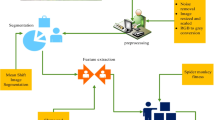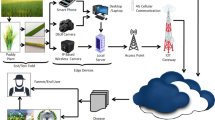Abstract
The management of crops from the early to mature stage contains nutrient deficiency, monitoring plant disease, controlling irrigation, and controlling the use of pesticides and fertilizers. Moreover, lack of immunity and climate changes cause the crops and minimize the growth of agriculture due to crop disease. The identification and detection of crop diseases is the most challenging task due to less detection accuracy, overfitting, and error rate. So this research work designed a novel Krill Herd based Random Forest (KHbRF) for the accurate detection of crop disease, enhancing the performance of detection accuracy by using an optimized fitness function. The krill herd fitness function is updated to the classification layer for effective crop disease detection. Furthermore, development involves preprocessing, segmentation, feature extraction, and classification. The developed framework is implemented in the python tool, and the plant villa image dataset is tested and trained in the system. After that preprocessing removes errors and feature extraction extracts the texture features from the crop. At last, the classification layer detects the crop disease present in the dataset using the fitness of the krill herd. Additionally, attained results of the developed framework are compared with other state-of-the-art techniques in terms of detection accuracy, sensitivity, F-measure, and error.










Similar content being viewed by others
Data availability
Data sharing is not applicable to this article as no new data were created or analyzed in this study.
Code availability
Not applicable.
Reference
Abbas A et al (2021) Tomato plant disease detection using transfer learning with C-GAN synthetic images. Computers Electron Agricult 187:106279
Alarcon P et al (2021) The Importance of a Food Systems Approach to Low and Middle Income Countries and Emerging Economies: A Review of Theories and Its Relevance for Disease Control and Malnutrition. Front Sustain Food Syst 5:92
Ang KL, Seng JKP (2021) Big Data and Machine Learning with Hyperspectral Information in Agriculture, IEEE Access
Antar M et al (2021) Biomass for a sustainable bioeconomy: An overview of world biomass production and utilization. Ren Sustain Energy Rev 139:110691
Arif I, Batool M, Schenk PM (2020) Plant microbiome engineering: expected benefits for improved crop growth and resilience. Trends Biotechnol 38(12):1385–1396
Ashapure A et al (2020) Developing a machine learning based cotton yield estimation framework using multi-temporal UAS data. ISPRS J Photogram Remote Sens 169:180–194
Balasundram SK et al (2020) Precision agriculture technologies for management of plant diseases. In: Plant Disease Management Strategies for Sustainable Agriculture through Traditional and Modern Approaches. Springer, Cham, pp 259–278
Ceballos F, Kannan S, Kramer B (2020) Impacts of a national lockdown on smallholder farmers’ income and food security: Empirical evidence from two states in India. World Develop 136:105069
Chamuah A, Singh R (2020) Securing sustainability in Indian agriculture through civilian UAV: a responsible innovation perspective. SN Applied Sciences 2(1):1–10
Chao X et al (2020) Identification of apple tree leaf diseases based on deep learning models. Symmetry 12(7):1065
Chen J et al (2020) Using deep transfer learning for image-based plant disease identification. ComputElectron Agricult 173:105393
Coulibaly S et al (2019) Deep neural networks with transfer learning in millet crop images. ComputIndus 108:115–120
de Bang TC et al (2021) The molecular–physiological functions of mineral macronutrients and their consequences for deficiency symptoms in plants. New Phytologist 229(5):2446–2469
de la Rosa G et al (2021) Interactions of nanomaterials and plants at the cellular level: current knowledge and relevant gaps. NanotechnolEnviron Engin 6(1):1–19
Flood J (2010) The importance of plant health to food security. Food Sec 2(3):215–231
Gabriel D et al (2020) Bacterial pathogens of citrus: Citrus canker, citrus variegated chlorosis and Huanglongbing. In: Genus Citrus. Woodhead Publishing, pp 371–389
Harakannanavar SS et al (2022) Plant leaf disease detection using computer vision and machine learning algorithms. Global Trans Proc 3(1):305–310
Holmelin NB (2021) National specialization policy versus farmers’ priorities: Balancing subsistence farming and cash cropping in Nepal. J Rural Stud 83:71–80
Hu W-J et al (2020) MDFC–ResNet: An Agricultural IoT System to Accurately Recognize Crop Diseases. IEEE Access 8:115287–115298
Khan S, Narvekar M (2020) Disorder detection of tomato plant (solanum lycopersicum) using IoT and machine learning. Journal of Physics: Conference Series. 1432. 1. IOP Publishing
Kundu N et al (2021) IoT and interpretable machine learning based framework for disease prediction in pearl millet. Sensors 21(16):5386
Li Y, Zheng Y (2021) Regional agricultural industry economic development based on embedded system and Internet of Things. Microproces Microsys 82:103852
Selvaraj MG et al (2020) Detection of banana plants and their major diseases through aerial images and machine learning methods: A case study in DR Congo and Republic of Benin. ISPRS J Photogram Remote Sens 169:110–124
Shahzad A et al (2021) Nexus on climate change: Agriculture and possible solution to cope future climate change stresses. Environ Sci Poll Res:1–22
Snelder DJ, Masipiqueña MD, De Snoo GR (2008) Risk assessment of pesticide usage by smallholder farmers in the Cagayan Valley (Philippines). Crop protection 27(3-5):747–762
Srivastava S, et al A Novel Deep Learning Framework Approach for Sugarcane Disease Detection. SN Comput Sci 1.2 (2020): 1-7.
Sujatha R et al (2021) Performance of deep learning vs machine learning in plant leaf disease detection. Microproc Microsyst 80:103615
Talari G, et al (2021)() State of the art review of Big Data and web-based Decision Support Systems (DSS) for food safety risk assessment with respect to climate change." Trends in Food Science & Technology
Tiwari P et al (2020) Phytohormones producing fungal communities: metabolic engineering for abiotic stress tolerance in crops. Agriculturally important fungi for sustainable agriculture. Springer, Cham, pp 171–197
Zin NA, Badaluddin NA (2020) Biological functions of Trichoderma spp. for agriculture applications. Annals of Agricultural Sciences 65(2):168–178
Author information
Authors and Affiliations
Corresponding author
Ethics declarations
Conflict of interest
The authors declare that they have no conflict of interest.
Human and animal rights
This article does not contain any studies with human or animal subjects performed by any of the authors.
Informed consent
Informed consent does not apply as this was a retrospective review with no identifying patient information.
Consent to participate
Not applicable
Consent for publication
Not applicable
Additional information
Publisher’s note
Springer Nature remains neutral with regard to jurisdictional claims in published maps and institutional affiliations.
Rights and permissions
Springer Nature or its licensor (e.g. a society or other partner) holds exclusive rights to this article under a publishing agreement with the author(s) or other rightsholder(s); author self-archiving of the accepted manuscript version of this article is solely governed by the terms of such publishing agreement and applicable law.
About this article
Cite this article
Srinivas, L.N.B., Bharathy, A.M.V., Ramakuri, S.K. et al. An optimized machine learning framework for crop disease detection. Multimed Tools Appl 83, 1539–1558 (2024). https://doi.org/10.1007/s11042-023-15446-2
Received:
Revised:
Accepted:
Published:
Issue Date:
DOI: https://doi.org/10.1007/s11042-023-15446-2




